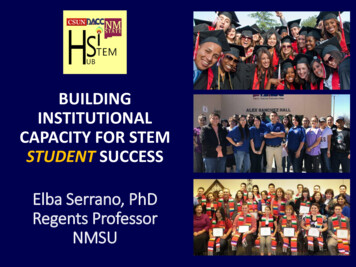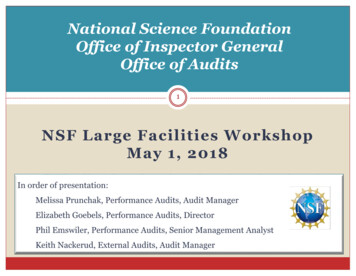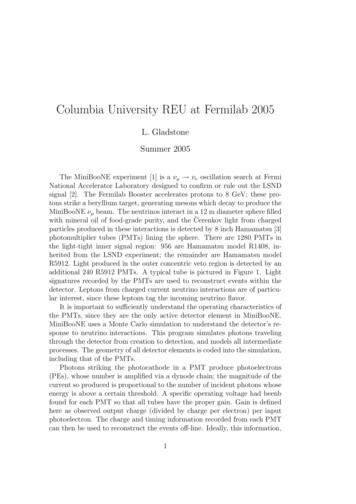
Transcription
Interfaces and Surfaces NSF REU SiteDepartment of Material Science and Engineering, Clemson UniversityMay-August sityofWisconsin- ic nanoparticles have recently been ofinterest due to their superparamagneticproperties, biocompatibility, and size, whichallows them to be a major candidate forbiomedical applications like magneticresonance imaging (MRI), drug delivery, andFigure 1: Schematic of crosslinking reaction with clusteredcancer treatment.[1] Factors that directly affectnanoparticlesthe nanoparticles’ ability to perform these applications are the particles magnetic properties and biologicalstability. For example, recent work has shown improved magnetic properties from creating clusters ofnanoparticles.[2] It was the goal of this project to create crosslinked clusters of particles, using iron oxide magneticnanoparticles modified with heterobifunctional polyethylene oxide ligands to give a background material thatoffers stability in biological environments.[3] Detailed herein is the production of a stable crosslink cluster network,which will theoretically have enhanced magnetic and stability properties due to increased size and enhancedanisotropy of the polymer-particle complexes. Figure 1 outlines the “bis-click” reaction[4] that will effectivelyproduce the crosslinked clusters.Results and Discussion:The particles that were synthesized had shown to be stable in variousbiological environments as well as at room temperature due to thestabilizing polymer modification. The ability to thermally induceclustering of the particle was first investigated by exposing particles toa range of temperatures from 20 C-70 C, with analysis shown in Fig.2. The study showed particle size was stable at around 70-80 nm forlower temperatures, and only at a critical temperature of 70 C did anyZ-Ave (d.nm)Z- ‐Avg(d.nm)Material and Methods:130HeatingCoolingThe particles used in the study were iron oxide nanoparticles[5]synthesized by thermal decomposition with an 8.5 nm diameter core110and these were modified with a heterobifunctional polyethylene oxidepolymer, which contained a ligand catechol group and terminating90alkyne group.[6] The bis-azide used in the crosslinking reaction wassynthesized from previous techniques reacting sodium azide and 1,470dibromobutane, with flash column chromatography for purification,50and the product was confirmed with 1H-NMR.[7] A copper-catalyzed020406080azide-alkyne cycloaddition (CuAAC) reaction, or “click” chemistryTemperaturewas utilized to react the alkyne polymer tips with a synthesized bisazide crosslink agent to produce the crosslink bridge in a single step Figure 2: Heating-cooling hydrodynamic“bis-click” reaction. All size measurements for particles were made size study from 20 C-70 Cwith the dynamic light scattering (DLS) on Malvern Zetasizer NanoSeries, and hydrodynamic size was represented with z-average valuesin nanometers. Transmission electron images captured with Hitachi240H7600 TEM and the samples were prepared on a copper grid withcarbon film. NMR spectroscopy was conducted with a Joel ECX-3001901409002004006008001000Time (min)Figure 3: Particle growth versus time forcrosslink reaction run at 80 C
lScienceandEngineering,ClemsonUniversityMay- ‐August2013observed size increase occur with particles measuring at 115nm. The thermal stability studies resulted in a criticaltemperature that would be used to build a background for thecrosslink reaction conditions to inducing clustering for thereaction. The reaction was then carried out with an excess ofcopper catalyst and bis-azide to ensure crosslinking at anelevated temperature of 80 C with a 14 hour reaction time.The reaction progress was measured with DLS by measuringparticle size every 12 minutes for the duration of the reaction.Figure 3 shows the growth progress of the particles during thereaction with the observed increase in size as expected, andthe growth rate decreasing with time. Measurements of theFigure 4: Particle size at 25 C before and afterparticles before and after the “click” reaction are shown incrosslinking reactionfigure 4, with hydrodynamic sizes being 67.8 and 279.5 nmrespectively. The schematics in figure 4 are a graphicalrepresentation the species before and after the reaction. Before the reaction the particles were relativelymonodispearse particles, and after the reaction the particle size increased due to the formation of crosslinkedclusters. The clusters also exhibited relatively low polydispersity, which means the clusters were all similar sizeswithout any substantially larger aggregates.A new sample was prepared with the same procedure as the previoussample, but with a reaction temperature of 70 C and with a further purified bis-azide molecule. The product fromthis reaction was then dialyzed for 3 days to remove any excess reagent from the sample. TEM images frombefore and after the reaction were obtained to attempt to verify the reaction via imaging. The images from beforethe reaction showed particles with a core size of around 8 nm without considerable aggregation within the sample,which is representative of the stability of the particles. The images for after the reaction showed particles ofincreased size, but due to the low resolution of the TEM, it could not clearly be detected as a cluster of particles,and further work with a high resolution TEM should be conducted to obtained higher quality images.Conclusion:The data from the crosslink reaction shows a stable species at room temperature with increased hydrodynamicsize, which suggests the crosslinking reaction was successful in creating a stable network of particles. Futureworks include further characterization on the crosslink species, for example relaxivity values, which relate to theimaging properties. Another further investigation could include varying temperature to change cluster size, andsynthesize larger core particles to explore any resulting magnetic changes after crosslinking the newly synthesizedparticles.Acknowledgments:This work was supported by the National Science Foundation’s REU program under grant number 1062873, CUCOMSET and the School of Materials Science and Engineering.Reference:[1] S. Laurent, S. Dutz, U.O. Hafeli, M. Mahmoudi, Adv Colloid Interfac, 166 (2011) 8-23.[2] N. Pothayee, S. Balasubramaniam, N. Pothayee, N. Jain, N. Hu, Y.N.A. Lin, R.M. Davis, N. Sriranganathan,A.P. Koretsky, J.S. Riffle, J Mater Chem B, 1 (2013) 1142-1149.[3] S.L. Saville, R.C. Stone, B. Qi, O.T. Mefford, J Mater Chem, 22 (2012) 24909-24917.[4] S.S. Pujari, H. Xiong, F. Seela, J Org Chem, 75 (2010) 8693-8696.[5] L.Y. B. Qi, R. Stone, C. Dennis, T. M. Crawford, O.T. Mefford, J. Phys. Chem., 117 (2013) 5429-5435.[6] B.Q. R. Stone, D. Trebatoski, O.T. Mefford, (2013).[7] J.R. Thomas, X.J. Liu, P.J. Hergenrother, J Am Chem Soc, 127 (2005) 12434-12435.
Interfaces and Surfaces NSF REU SiteDepartment of Materials Science and Engineering, Clemson UniversityMay-August 2013Capillary Channel Polymer Fibers Processed for Use as Micro-carriers in Nerve Regeneration1T. Le1, K. Stevens2, K. Webb3Department of Chemical and Material Engineering, University of California, Davis, 956162School of Material Science and Engineering, Clemson University, SC 296343School of Bioengineering, Clemson University, SC 29634Introduction: Capillary channel polymer (CCP) fibers, non-woven fibers with novel cross-section, have beenshown to be effective scaffold for cell growth in the study of cell regeneration in ligament treatment. In this study,injectable sized CCP fibers are used as micro-carriers in nerve regeneration. The result of this study will befoundational work for continual research and eventual application for minimally invasive treatment ofneurodegenerative diseases. This study will focus on cell viability and attachment on fibers during seeding andafter transferring process, using needles of various gauges.Materials and Methods:Fiber Spinning Process:PLA polymers were dried in oven at 60 C under nitrogen flow overnight to ensure no moisture before spinning.Spin with controlled temperatures and in low humidity condition to maintain cross-section.Fiber Cutting:1. Prepared a mold half filled with OCT. Freeze the OCT with liquid nitrogen.2. Put OCT onto a length of fibers to make it easier to fold. Fold fiber length repeatedly to make a bundle.3. Submerge the bundle into liquid nitrogen to freeze for easy handling.4. Use scissors to make additional hole in the frozen mold of OCT.5. Cut off the tips of the bundle with a scissors. Plant the frozen bundle of fibers into the mold.6. Fill in OCT to the top and freeze the mold. Use blade to cut off protruding parts to make surface of mold even.7. Attach mold onto cryotome platform using OCT.8. Use cryotome machine for cutting with thickness set at 50 microns.Fibers Washing and Sterilization Process:1. Wash OCT off fibers in centrifuge tube 3 times with DI water. Remove supernatant2. Sonicate for 1 hour at 40 degree Celsius. Repeat three times with fresh DI water each time.3. Confirm with ATR-FTIR and SEM images that no OCT residue is left.Sterilization process has to be done in laminar hood except when centrifuging1. Fill tube with 70% Ethanol until all fibers are submerged. Let it sit for 30 minutes.2. After 30 minutes, wash fibers with sterile water 4 times. Remove supernatant.Fibers Preparation for Cell Seeding:1. Prepare dilution of 20µg/mL fibronectin. Put fibronectin solution into tube w/ fibers, vortex a little for evenfibronectin coating. Let it sit overnight.2. After overnight storage, wash fibronectin out 3 times with filtered 1x PBS with Ca / Mg .3. Dilute fibers concentration in tube with cell culture media depending on the amount of fibers in the tube ( 12ml of media would suffice).4. Put 50µL aliquot of fibers media mixture into each well on a 96 wells plate. Use as many wells as needed. Leftover fibers media can be stored in refrigerator.5. Slightly swirl the plate for an even fiber distribution and store plate in incubator until needed.Cell Passaging and Seeding:1. Follow normal procedure for 3T3 fibroblasts cell passaging in sterile environment using cell culture media,DMEM w/ L-glutamine AB (penicillin) BGS, trypsin, and filtered 1x PBS (Mg /Ca ).2. Use hemocytometer to count cells. Calculate volume of cells media needed for 40,000 cells.3. Seed calculated amount of cells into wells, taking note of wells and cell counts.4. Add more media to make a total of 200 microliter media in each well. Incubate5. Observe progress with viability, actin, and nuclei dyes.
Interfaces and Surfaces NSF REU SiteDepartment of Materials Science and Engineering, Clemson UniversityMay-August 2013Transferability Experiment:1. Pipette out seeded fibers from well with cut-tip pipette. Avoid scraping the bottom of well.2. Remove pump from syringe’s body. Pipette the fibers media into syringe. Reinsert the pump.3. With the needle attached, transfer fibers from syringe to a clean well.4. Incubate for 2-3 hours and check for cells viability.Results and Discussion:Initial results clarify the success of the first stage of research: cutting fibers into small lengths and get fibroblaststo grow on them. The result also indicates that cells can grow and attach to micro fibers no matter whatorientations the fibers are in due to the novel design of the cross-section. The high level of cells interaction andfibers aggregation seen in fig. 2, 7 days after seeding show that cells can strongly proliferate and that they canreach out to surrounding to establish connection.The results for the transferability experiment show that after passing through a range of needle gauges, cells arestill attached to fibers and survive. The grooves on the cross section most likely play a significant role in keepingthe cells on the fibers during transfer. Seeded fibers can be transferred through a 25G needle, which is close to the27G target, a common gauge for brain injection. However, almost none of the fibers could get through the 30Gneedle.PVAspectrum Fig.1:Theredcurveisthefiberif exists. eseen.Conclusions: The method of cutting and fiber processing proves to be successful as cells were able to attach tothe fibers, and no residue from the cutting embedding medium was left. This study shows that PLA CCP fiberseffectively act as micro-carriers that support cell growth and control cell morphology and alignment. 3T3fibroblasts attachment and proliferation on injectable sized fibers shows potential in further research intoneurodegenerative disease treatment. Not only that, the seeded fibers can also be transferred using needle whilemaintaining cell’s viability and attachment, an important step toward clinical application in the future.Future work: Seeding cells onto smaller length fibers (100-150 microns). Dispersing seeded fibers into hydrogel composition to see if fibroblasts will extend out into hydrogel.Ultimately, the goal would be to inject a hydrogel composition of seeded fibers and cell growth biaseddrugs into target area of the brain. Seed neurons onto PLA CCP fibers and then onto different polymer fibers with shorter biodegradabletime. Seed neuron stem cells (NSCs) onto CCP fibers. Further research on differentiation of NSCs to neurons.
Interfaces and Surfaces NSF REU SiteDepartment of Materials Science and Engineering, Clemson UniversityMay-August 2013Acknowledgements: I would like to thank Graduate Students: Atanu Sen, Lee Ho Joon, Histology Lab Manager,Chad McMahan, Cell and Tissue Culture Lab Manager, Cassie Gregory, and MSE Analytical Lab Manager,Kimberly Ivey. This work was supported by the National Science Foundation’s REU program under grant number1062873, CU COMSET, the School of Material Science and Engineering, and the School of Bioengineering.
Interfaces and Surfaces NSF REU SiteDepartment of Materials Science and Engineering, Clemson UniversityMay-August 2013Hardness Evolution of Metallic Surfaces due to Wear TestingR. Askew1, C. Eljach2, J. DesJardins2College of Engineering, Tuskegee University, 360882Department of Bioengineering, Clemson University, 296341Introduction: TKRs are a successful orthopedic surgery; however, there are a high number of revisionsthat occur every year. Previous work has shown that the most common limiting factor in theperformance of TKR joints has been the wear of ultra-high molecular weight polyethylene (UHMWPE)used as a bearing component [1]. Cobalt chrome (CoCr) is one of the most commonly used metal in thefemoral component in knee replacements. Polyethylene is a plastic spacer placed between the femoraland tibial components. Titanium metal is used in the tibial component in TKRs. Wear is described as:the process of material loss due to some friction. In this study, we focus on the Cobalt chrome instead,primarily because in previous studies the focus has been of the non-articulated cobalt chrome. Our studyis to determine whether or not the wear process affected the pin’s hardness.Materials and Methods: Six Cobalt Chrome metal alloys (distributed by DJO surgical) were selectedfor this study for wear testing in the orthopod. A UMT Multi-Specimen Test System in a pin-on-discmode was used to create twelve different loads on Cobalt Chrome pins ranging from 1N to 12N. Afterthe pin-on-disc method, CoCr pins are weighed and examined through Vickers Microhardness Tester(Huayin HV-1000B). Pins undergo wear testing in orthopod which utilizes bovine serum (composed of75% deionized water) as lubrication to serve as synovial fluid found in a human knee. Polyethyleneserves as a spacer during wear testing. Orthopod loads CoCr pins onto polyethylene surface and begins acircular motion. After wear testing, CoCr are measured for hardness (HV) which determines the strengthand compatibility of Cobalt Chrome prior to five year implantation (80km).Results and Discussion: At 0km each point (left, right and inside of the scratch) was found to be greaterthan the “clean area” by 50. Change in material hardness (an average of 44.22 HV for each point offocus) is discovered following wear testing of up to 80km. The hardness gap was decreased due to weartesting. Logically, change in hardness was expected as a result of activity (walking, minimal exercise,etc.). Once CoCr pins reach 80km the difference in hardness was reduced to an average of 15.8. In Table1, the considered “Clean Area” decreased in hardness by 21.7HV, Left Side of Scratch by 55.3HV,Inside of the scratch by 53HV and the Right Side of Scratch by 46.8HV. We hypothesized that therewould be a change in hardness due to wear testing; results have shown us just that. In conclusion, overfive years implantation hardness values decreased by an average of less than 16%. Using a t-test inexcel, each area were tested from before wear at 0km to following wear at 80km. In conclusion each pvalue had a value of 0.5; therefore, hardness evolution was statistically significant as shown in Table 1:
Interfaces and Surfaces NSF REU SiteDepartment of Materials Science and Engineering, Clemson UniversityMay-August 2013Hardness Vickers (HV)Hardness Evolution: 0KM versus80KM3503002502001501005000KM "clean"80KM "clean"0KM inside80KM insideTable 1: This tablerepresents the hardnessaverages from 0KM to80KM from each point offocus.0KM left80KM left0KM rightConclusion: Excessive loading during hardness testing can cause inaccurate measurements resulting inindenting through the material resulting in catastrophic damage. Adjust study to replicate aggressive invivo damage and focus on properties of active patient and apply. Possibly quantify wear and hardness ina single project to determine a correlation.Acknowledgements:I would like to thank Dr. DesJardins and Caleb Eljach for their assistance,patience and guidance with my project. Also, I would like to thank Dr. Kennedy for the opportunity andher Ph.D. student, Brad Schultz. This work was supported by the National Science Foundation’s REUprogram under grant number 1062873, CU COMSET and the School of Materials Science andEngineering.References:[1] Vaidya C, et al. Reduction of total knee. 2011. 225(H1):1-7.
Interfaces and Surfaces NSF REU SiteDepartment of Materials Science and Engineering, Clemson UniversityMay-August 2013Dynamic Simulations of Self-healing Polymer1R.K. Bay1, Y. Yang2, M.W. Urban2Department of Material Science and Engineering, Rensselaer Polytechnic Institute, 121802Department of Materials Science and Engineering, Clemson University, 29634Introduction: When damage occurs to a polymer, the chains undergo cleavage and slippage. For thepolymer to self-heal, bond reformation and network repairs must occur under favorable thermodynamicconditions. In this study, computer simulations are utilized for the first time to understand physicalresponses of self-healing. When a polymer is scratched the glass transition temperature is decreased atthe interface of the scratch and the interface is above glass transition temperature. When a polymer isabove the glass transition temperature it is in a rubber state compared to its glass state. The interface thatis above glass transition temperature flows to fill the scratch. From past studies, as the scratch heals asymmetrical ridge is observed at the bottom of the scratch and a scar forms on the surface of thepolymer. The scar on the surface is from the free volume of the polymer [1][2][3].Materials and Methods: In this study Comsol Multiphysics software was used to create a simulation ofthe self-healing of a polymer. In this simulation it was assumed that the flow was incompressiblebecause the polymer was flowing in its solid rubbery state. Thermoset polyurethane was used as thesimulation polymer at a density of 1.17 g/cm3. Atmospheric pressure on the open interface of thegeometry was assumed and a healing volume force was applied to the geometry. The healing volumeforce can be from the activation energy to have the polymer chains move. The geometry of the scratchwas 60 meters deep, 20 meters wide, and 10 m thickness between the surfaces of the scratch in whichthe polymer was allowed to flow. Meters were used instead of microns because of the computation timeto run the simulation required was much higher in microns than to run the simulation in meters. Thehealing volume force was increased to 10 N/m3 with the understanding that the actual force from thechemical bonds breaking from the scratch ranges from 10-6 to 10-10 N/m3 in the micrometers geometry.Laminar flow and turbulent flow simulation were compared to identify the type of flow that forms thesymmetrical ridge. The laminar flow model used the Non-Newtonian Carreau Model with an infinitedynamic viscosity of 15Pa*s. The k-ε turbulence model was used to model the turbulent flow. Theviscosity of the scratch surfaces has not been measured before therefore the dynamic viscosities of 10Pa*s and 15 Pa*s to identify if healing dynamics changed with a change in viscosity. Round and sharpscratch bottom surface were compared to identify which one was able to form the symmetrical ridge.Results and Discussion: In the turbulent flow models, the growing of a symmetrical ridge is observedin the bottom of the scratch due to a pressure buildup below the scratch (Figure 1). The polymer flowsinitially from the top of the geometry in a laminar state in both the turbulent models and the laminarmodel. The increasing the viscosity in the turbulent model from 10 Pa*s to 15 Pa*s increases the heightof the symmetrical ridge by one meter. In the non-Newtonian laminar flow the surface closes together tocreate a new round surface and an increase in pressure is observed below the scratch and no symmetricalridge is observed. For the sharp geometry, the surface closes together and creates new sharp bottomsurface in the turbulent model, and pressure build up is observed below the surface although nosymmetrical ridge is observed. The simulation was able to run until the boundaries of the inside ofscratch collided. When the boundaries collided the software was not able to recognize the boundaries didnot exist anymore and therefore the growth of the ridge was stopped. When the boundaries collide in the
Interfaces and Surfaces NSF REU SiteDepartment of Materials Science and Engineering, Clemson UniversityMay-August 2013simulation it represents bond reformation and network repair. If the simulation was run after the pointthe boundaries collided the material would start to overlap and a loss of material would occur.Figure 1. Pressure plot of the turbulent model with a dynamic viscosity of 10 Pa*s and roundbottom geometry. A symmetrical ridge is observed with a pressure point at (0, 3.3) around234.1kPa.Conclusions: During healing a symmetrical ridge in the bottom of scratch is formed by a pressurebuildup. The symmetrical ridge grows up until the polymer is fully healed. The symmetrical ridge isformed due to turbulent flow, indicated by the simulation. The bottom of the scratch has to be round forthis symmetrical ridge to occur.Acknowledgements: This work was supported by the National Science Foundation’s REU programunder grant number 1062873 and the Center for Optical Materials Science and EngineeringTechnologies (COMSET).References:[1] B. Ghosh, M. W.Urban, Science. 2009, 323, 1458-1460.[2] B.Ghosh, K.V. Chellappan, M.W.Urban, B. Ghosh , J. Mater. Chem., 2011, 21,14473-14486.[3] B. Ghosh , K. V. Chellappan and M. W. Urban, J. Mater. Chem., 2012, 22, 16104-16113.
Interfaces and Surfaces NSF REU SiteDepartment of Materials Science and Engineering, Clemson UniversityMay-August 2013Reconfigurable Diffraction Gratings with Magnetic NanorodsJ.Custer1, Y. Gu1, K. Kornev11Department of Materials Science and Engineering, Clemson UniversityIntroduction:The purpose of this study was to develop a reconfigurable diffraction grating by using magneticnanorods. Such a diffraction grating would be of use in advancing the field of spectrometry. Diffractionis a phenomenon that causes light to spread out after being transmitted through a small opening. Adiffraction grating creates such openings in the form of regularly spaced gaps. The distance between thegaps and the wavelength of light determine the resulting diffraction pattern. Most diffraction gratingshave a set gap size and thus cannot be reconfigured. This study sought to use a magnet to align nickelnanorods in a fluid and to use the gaps between the nanorods as a diffraction grating. Becauserepositioning the nanorods with a magnet could control the gap size, the grating would be reconfigurablewhich would allow for more versatile spectrometers. This would be beneficial to applications ofspectrometers including material identification and use in endoscopes.Materials and Methods:The synthesis of the nickel nanorods followed the traditional electrolysis procedure.1-An inorganic filtermembrane with 0.2 mm pore size was coated with gallium-Indium. The coated membrane was placedupon a copper plate (coating side down) and a graduated cylinder that was open on both ends wasclamped over it. A WATTS solution (300g/L NiSO4*H2O, 45g/L H3BO3, 45g/L NiCl2*6H2O) waspoured into the graduated cylinder and a nickel wire was placed in the solution. A negative lead wasattached to the copper plate, and a positive lead was attached to the nickel wire. Electricity was appliedfor 12 minutes at 1.5 V. Nitric acid was then used to remove the gallium-Indium coating on themembrane. The membrane was dissolved in a solution that consisted of 4% NaOH, 2% PVP(Polyvinylpyrrolidone) and 94% H2O (percentage is by weight). The PVP coated the nickel nanorodsand prevented aggregation.2 After dissolving in the NaOH solution for at least 24 hours; the nanorodswere sonicated and then transferred to a glycerin solution using a centrifuge. This resulting solution wasviewed under a dark field microscope at 50X magnification and contained distinct nanorods devoid ofaggregation. In the presence of a magnetic field, the nanorods would rotate in order to orientatethemselves parallel to the field. When a field gradient was present, the magnetic force would drag thenanorods towards the higher field position. As the nanorods reached the edge of the drop, they wouldform chains while remaining parallel to the magnetic field and maintaining separation from the otherchains (See figure 1 on next page). A red laser (wavelength of 635 nm) was directed through a sample ofthe solution containing the nickel nanorods. When a magnet was placed underneath the sample (thuscausing the magnetic field to be perpendicular to the laser), a diffraction pattern appeared upon a screenplaced 0.5 m behind the sample. This diffraction was in the form of a solid line that could be rotated bymoving the magnet to the right or left of the sample.Results and Discussion:Adding PVP to the NaOH solution caused the PVP to coat the nanorods, which helped the nanorods toavoid aggregation. The nanorods were also more stable in glycerin than in water. This was clearly seenby comparing images of nanorods in each of the two solutions. The nanorods in water formed large
Interfaces and Surfaces NSF REU SiteDepartment of Materials Science and Engineering, Clemson UniversityMay-August 2013bundles while the nanorods in glycerin remained separate for the most part and would only attach toeach other at the ends of the nanorods. When a magnetic field was applied, the nanorods essentiallybecame induced bar magnets that could line up head to tail, but would show repulsion between the shaftsof the nanorods. This explains why the nanorods would form chains (head to toe bonding) that wouldstay separate from other chains (shaft repulsion). See Figure 1 on the next page. The diffractionobserved was caused by the gaps between these chains. However, because of the inhomogeneity in thegap distances, the peaks of the diffraction pattern could not be reliably distinguished.Figure 1. PVP coated nanorods in glycerol in presence of a magnet, dark field imageConclusions:Nickel nanorods appear to be a viable method to creating a reconfigurable diffraction grating. This studyhas shown that it is possible to create nanorods that can be manipulated magnetically and that will notconglomerate into large bundles. Also, these nanorods have been observed to cause diffraction, althoughthe diffraction achieved was not distinct enough to allow for much analysis. However, the use of a clearmicrochannel is hoped to be implanted in the future. The width of the microchannel will beapproximately the height of the nanorods. This should stop the nanorods from forming chains and allowonly the shafts of the nanorods to interact with each other. This would permit more precise control of thespacing between the nanorods as well as a more consistent gap size. Having a more consistent gap sizewill cause the diffraction pattern to appear more distinctly allowing for uses in spectrometry.Acknowledgements:This work was supported by the National Science Foundation’s REU program under grantnumber 1062873 and the Center for Optical Materials Science and Engineering Technologies(COMSET).References:1Bentley, A. K.; Farhoud, M.; Ellis, A. B; Lisensky, G. C; Nickel, A. L.; Crone, W. C. TemplateSynthesis and Magnetic Manipulation of Nicke
Sterilization process has to be done in laminar hood except when centrifuging 1. Fill tube with 70% Ethanol until all fibers are submerged. Let it sit for 30 minutes. 2. After 30 minutes, wash fibers with sterile water 4 times. Remove supernatant. Fibers Preparation for Cell Seeding: 1. Prepare dilution of 20µg/mL fibronectin.




![WELCOME! [tdlc-reu.ucsd.edu]](/img/26/2015-16-reu-orientation.jpg)





